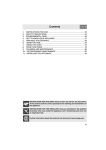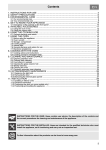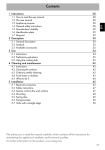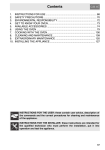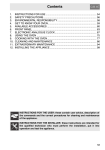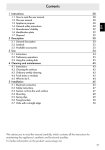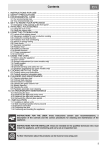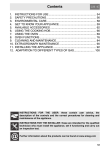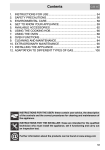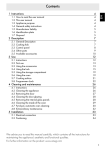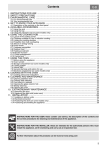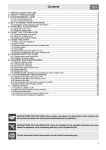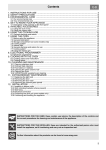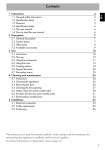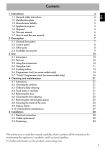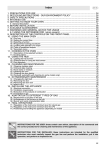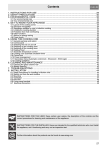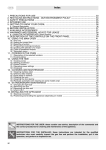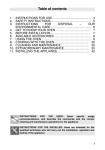Download 477 5198 CS19ID-7-A1PYID-7.book(03 477 5198 GB.fm)
Transcript
Contents 1. 2. 3. 4. 5. 6. 7. 8. 9. 10. 11. INSTRUCTIONS FOR USE .............................................................. 50 SAFETY PRECAUTIONS ................................................................. 52 ENVIRONMENTAL CARE................................................................. 54 GET TO KNOW YOUR APPLIANCE ................................................ 55 AVAILABLE ACCESSORIES ............................................................ 58 USING THE COOKING HOB............................................................ 62 USING THE OVEN ........................................................................... 68 OVEN FUNCTIONS .......................................................................... 74 CLEANING AND MAINTENANCE.................................................... 82 EXTRAORDINARY MAINTENANCE ................................................ 88 INSTALLING THE APPLIANCE ........................................................ 90 INSTRUCTIONS FOR THE USER: these contain user advice, the description of the controls and the correct procedures for cleaning and maintenance of the appliance. INSTRUCTIONS FOR THE INSTALLER: these are intended for the qualified technician who must install the appliance, set it functioning and carry out an inspection test. @ Further information about the products can be found at www.smeg.com 49 General instructions 1. INSTRUCTIONS FOR USE This manual is an integral part of the appliance. It must be kept in its entirety and in an accessible place for the whole working life of the appliance. We recommend reading this manual and all information it contains carefully before using the appliance. Installation must be carried out by qualified personnel in accordance with the standards in force. This appliance is intended for domestic use and conforms to the EC directives currently in force. The appliance has been built to carry out the following functions: cooking and heating up food; all other uses are considered unsuitable. These instructions are valid only for the destination countries whose identifying symbols are included on the cover of this manual. Never obstruct the openings and slots provided for ventilation and heat dispersal; this may cause malfunctions. Do not use this appliance for heating rooms. This appliance is marked according to European directive 2002/96/EC on Waste Electrical and Electronic Equipment (WEEE). This directive defines the standards for the collection and recycling of waste electrical and electronic equipment applicable throughout the European union. The identification plate with technical data, serial number and brand name is located in an exposed position either in the drawer (where present) or on the back of the appliance. A copy of the identification plate is included in the booklet. It should be applied to the appropriate space on the back of the cover. Do not remove this plate for any reason. Before the appliance is put into operation, all labels and protective films applied on external surfaces must be removed. Do not use metallic sponges or sharp scrapers as they will damage the surface. Use normal non-abrasive products and a wooden or plastic tool if necessary. Rinse thoroughly and dry using a soft cloth. Do not allow residues of sugary foods (such as jam) to set inside the oven. If left to set for too long, they might damage the enamel lining of the oven. Do not use plastic kitchenware or containers. The high temperatures inside the oven could melt the plastic, damaging the appliance. Always check that the control knobs are in the “zero” (off) position when you finish using the appliance. 50 General instructions Do not use sealed tins or containers in the appliance. Overpressure may occur inside the containers during cooking, creating a danger of explosion. Do not cover the bottom of the oven with aluminium or tin foil sheets during cooking and do not place pans or trays on it to avoid damage to the enamelled surface. Never place saucepans with bases which are not perfectly flat and smooth on the hob. Unstable cookware can lead to scalding. Do not rest any weight or sit on the open door of the appliance. Excessive weight may jeopardise its stability. The appliance becomes very hot during use. Suitable heat-proof gloves should be worn for all operations. Do not use the hob if pyrolysis (where present) is taking place inside the oven. If you intend to go away for a prolonged period of time, close the mains gas tap or the gas cylinder tap. Take care that no objects are stuck in the door of the oven. Do not open the storage compartment (where present) when the oven is on and still hot. The temperatures inside it may be very high. If the surfaces are still very hot during cooking, do not pour water directly onto the trays. The steam could cause severe burns and damage enamelled surfaces. All cooking operations must take place with the door closed. The dissipation of heat may cause hazards. The manufacturer declines all responsibility for damage to persons or things caused by non-observance of the above prescriptions or by interference with any part of the appliance or by the use of non-original spare parts. 51 General instructions 2. SAFETY PRECAUTIONS Consult the installation instructions for safety standards on electrical or gas appliances and for ventilation functions. In your interests and for your safety the law requires that the installation and servicing of all electrical and gas appliances be carried out by qualified personnel in accordance with the standards in force. Our approved installers guarantee a satisfactory job. Gas or electrical appliances must always be uninstalled by suitably skilled people. Before connecting the appliance to the power grid, check the data on the plate against the data for the grid itself. If the appliance is installed on a raised platform, secure it using suitable fastening systems. Before carrying out installation/maintenance work, make sure that the appliance is disconnected from the power grid. If cooking appliances are installed in motor vehicles (for example, camper vans, caravans etc.), they must only be used when the vehicle is stationary. Install the appliance so that when opening the drawers or doors of units positioned at the level of the hob there is no possibility of making contact with pans positioned on top of it. The plug to be connected to the power supply cable and its socket must be of the same type and conform to the standards in force. The socket must be accessible after the appliance has been installed. Never disconnect the plug by pulling on the cable. If the power supply cable is damaged, contact the technical assistance centre immediately and they will replace it. The appliance must be connected to earth in compliance with electrical system safety standards. During use the appliance and its accessible parts become very hot. Take care never to touch the heating elements. Keep children younger than 8 away from the appliance, unless under continuous supervision. If a crack forms on the the glass ceramic cooking surface, turn off the appliance immediately and contact the technical assistance centre. Never put inflammable objects in the oven: they could be accidentally ignited and cause fires. 52 General instructions The appliance is intended for use by adults. Do not allow children to go near it or play with it. This appliance may be used by children from the age of 8 and by people of reduced physical and mental ability or lacking in experience and knowledge, provided they are supervised or instructed on the safe use of the appliance and if they understand the associated risks. Do not allow children to play with the appliance. Do not allow unsupervised children to perform cleaning or maintenance operations. Never attempt to repair the appliance. All repairs must be carried out by an authorised technician or at an authorised service centre. The improper use of tools can cause hazards. This appliance must not be controlled using an external timer or remote control system. Be aware of how rapidly the cooking zones heat up. Do not place empty saucepans on the heat. Danger of overheating. Fats and oils can catch fire if they overheat. You are therefore recommended not to leave the appliance unattended while preparing foods containing oils or fats. If fats or oils catch fire, never put water on them. Place the lid on the saucepan and turn off the cooking zone. Take care when using additional electrical appliances in the kitchen (e.g. blender, toaster etc.). Connection cables must not come into contact with hot cooking zones. Do not use steam jets for cleaning the appliance. The steam could reach the electronics, damaging them and causing short-circuits. Do not spray any spray products near the household appliance while it is in operation. Do not use spray products while the appliance is still hot. The gases contained in spray cans may catch fire. The manufacturer declines all responsibility for damage to persons or things caused by non-observance of the above prescriptions or by interference with any part of the appliance or by the use of non-original spare parts. 53 Instructions for disposal 3. ENVIRONMENTAL CARE 3.1 Our environmental care Pursuant to Directives 2002/95/EC, 2002/96/EC and 2003/108/EC relating to the reduction of the use of hazardous substances in electrical and electronic appliances, as well as to the disposal of refuse, the crossed out bin symbol on the appliance indicates that the product, at the end of its working life, must be collected separately from other refuse. Therefore, the user must consign the product that has reached the end of its working life to the appropriate selective collection centres for electrical and electronic refuse, or deliver it back to the retailer when purchasing an equivalent product, on a one for one basis. Adequate selective collection for the subsequent forwarding of the decommissioned product to recycling, treatment and ecologically compatible disposal contributes to avoiding possible negative effects on the environment and on health and promotes the recycling of the materials of which the appliance consists. Illicit disposal of the product by the user will lead to the application of administrative sanctions. The product does not contain substances in quantities sufficient to be considered hazardous to health and the environment, in accordance with current European directives. 3.2 Your environmental care Our product's packaging is made of non-polluting materials, therefore compatible with the environment and recyclable. Please help by disposing of the packaging correctly. You can obtain the addresses of collection, recycling and disposal centres from your retailer or from the competent local organisations. Do not discard the packaging or any part of it, or leave it unattended. It can constitute a suffocation hazard for children, especially the plastic bags. Your old appliance also needs to be disposed of correctly. Important: hand over your appliance to the local agency authorised for the collection of electrical appliances no longer in use. Correct disposal enables intelligent recovery of valuable materials. Before disposing of your appliance it is important to remove doors and leave shelves in the same position as for use, to ensure that children cannot accidentally become trapped inside during play. It is also necessary to cut the connecting cable to the power grid, removing it along with the plug. 54 Instructions for the user 4. GET TO KNOW YOUR APPLIANCE Multifunction models Pyrolytic Model 1 Cooking hob 5 Fan 2 Control panel 6 Oven light 3 Oven seal 7 Storage compartment 4 Door Frame shelf 55 Instructions for the user 4.1 Description of the controls on the front panel Multifunction models Pyrolytic Model 1 Programming clock The programming clock makes it possible to display the current time or to set a timer or a programmed cooking operation. 2 Temperature selection knob The cooking temperature is selected by turning the knob clockwise to the required setting, between the maximum and the minimum settings. 56 Instructions for the user 3 Thermostat indicator light (On multifunction models only) The indicator light comes on to indicate that the oven is heating up. When this light goes out, the preset heating temperature has been reached. When the light flashes regularly, it means that the temperature inside the oven is kept steady on the set level. (On pyrolytic models only) When the indicator light is flashing, it indicates that the oven is heating up to the temperature set using the thermostat knob. Once the oven has reached the selected temperature, the light stops flashing and remains lit steadily until the oven is switched off. Moreover, the light switches on when the automatic cleaning cycle (pyrolysis) starts and remains lit until the cycle is complete. 4 Function selection knob The oven's various functions are suitable for different cooking modes. After selecting the required function, set the cooking temperature using the thermostat knob. For more information on cooking functions, see: “8. OVEN FUNCTIONS”. 5 Cooking zones control knob Using these knobs you can control the cooking zones of the induction hob. The hot plate controlled is indicated above every knob. Turn the knob to the right to adjust the operating power of the hot plate that goes from a minimum of 1 to a maximum of 9. The working power is indicated on a display positioned on the hob. 6 Door lock indicator light (on pyrolytic models only) It switches on when the automatic cleaning cycle (pyrolysis) is activated. 57 Instructions for the user 5. AVAILABLE ACCESSORIES NOTE: Some models are not provided with all accessories. Wide rack: useful for holding cooking containers. It can be placed on top of a tray for cooking foods which may drip. Narrow rack: useful for cooking small sized food, such as meat. It can be placed on top of a tray for cooking foods which may drip. Tray: useful for collecting fat from foods placed on the rack above. Necessary when using the rotisserie. Rotisserie supports: rotisserie rod. They support the Rotisserie rod: for cooking chicken and all foods which require uniform cooking over their entire surface. Scraper: useful for cleaning the glass ceramic hob. Do not use on other surfaces. 58 Instructions for the user • The oven accessories intended to come into contact with food are made of materials that comply with the provisions of Directive 89/109/EEC, dated 21/ 12/88, and of Legislative Decree 108, dated 25/01/92. • Accessories available on request: Original supplied and optional accessories may be ordered from any Authorised Assistance Centre. Use only original accessories supplied by the manufacturer. • 5.1 Using the oven racks and trays The racks and trays are equipped with a mechanical safety lock which prevents them from being taken out accidentally. To insert the rack or tray correctly, check that the lock is facing downwards (as shown in the figure at the side). To remove the rack or tray, lift the front slightly. The mechanical lock (or the extension piece where present) must always face the back of the oven. Gently insert racks and trays into the oven until they come to a stop. 59 Instructions for the user 5.2 Using the rotisserie rod Keep the oven door closed during cooking. Use the clip forks provided to prepare the rotisserie rod with the food. The clip forks can be tightened using the fastening screws. Place the rotisserie supports into the inserts at the corners of the tray. The supports should be placed as shown in the adjacent figure. Place the rotisserie rod on the supports. Make sure the pins are correctly positioned on the shaped part of the supports. 60 Instructions for the user After having prepared the rotisserie rod, place the tray on the first runner (see 4. GET TO KNOW YOUR APPLIANCE). Rocking the rotisserie supports, insert the tip of the rotisserie rod into the hole of the rotisserie motor on the side of the oven. At the end of cooking, screw on the handle provided so that you can move the rod with the food on it readily. Pour a little water in the drip tray to prevent smoke from forming. Regular flashing of the thermostat indicator light during cooking is normal and indicates that the temperature inside the oven is being maintained constant. 61 Instructions for the user 6. USING THE COOKING HOB 6.1 General warnings and advice On first connection to the electrical mains, an operating check will be carried out automatically and all indicator lights will come on for a few seconds. After use, turn off the hot plates used returning the appropriate knob to the “O” position. Never rely solely on the cookware detector. Never place metal objects, such as dishes or cutlery, on the induction hob surface as they may overheat: Danger of burns. Take care not to spill sugar or sweet mixtures onto the hob when hot. Never place materials or substances which may melt (plastic or aluminium foil) on the hob. If this occurs, promptly switch off the cooking zones and remove the molten material with the scraper provided while the hot plate is still lukewarm to prevent the surface from being damaged. The hob is equipped with an induction generator for each cooking zone. Each generator located under the glass ceramic cooking surface creates an electromagnetic field which induces a thermal current in the base of the saucepan. This means the heat is no longer transmitted from the hob to the pan but created directly inside the pan by the inductive current. 6.2 Zone 1 2 3 4 Layout of the cooking zones Outer diameter (mm) 145 180 270 210 Max absorbed power (W) * 1400 1850 2600 2300 Absorbed power in booster function (W) * 2200 3000 3700 3700 * power levels are indicative and can vary according to the pan used or the settings made. 62 Instructions for the user To prevent damage to the appliance or adjacent units, all pans or griddles must be placed inside the perimeter of the hob. 6.3 Cookware suitable for use in induction cooking On first connection to the electrical mains, an operating check will be carried out automatically and all indicator lights will come on for a few seconds. Use only cookware with bases suitable for induction hot plates. Suitable cookware: • Enamelled steel cookware with thick bases. • Cast iron cookware with an enamelled base. • Cookware in multilayer stainless steel, ferritic stainless steel and aluminium with a special base. Unsuitable cookware: • Copper, stainless steel, aluminium, fireproof glass, wood, ceramic and terracotta cookware. To see whether the pan is suitable, bring a magnet close to the bottom: if it is attracted, the pan is suitable for induction cooking. If you do not have a magnet, you can put a small amount of water in the pan, place it on a cooking zone and start the hot plate. If the symbol appears on the display, it means the pan is not suitable. Use only cookware with a perfectly flat bottom. Using cookware with an irregular bottom could jeopardise the efficiency of the heating system so that the cookware is not detected on the hot plate. 63 Instructions for the user 6.4 Limiting the cooking duration The hob has an automatic device which limits the duration of use. If the cooking zone settings are not changed, the maximum duration of operation of each zone depends on the power level selected. When the device for limiting the duration of use is activated, the cooking zone turns off, a short alert is sounded and if the zone is hot the symbol will show on the display. 6.5 Protection from hob overheating If the hob is used on full power for a long period, the electronics will have trouble cooling down if the room temperature is high. To avoid excessively high temperatures forming in the electronics, the power to the cooking zone is managed automatically. 6.6 • • • • • • 64 Advice on energy-saving The diameter of the base of the saucepan must correspond to the diameter of the cooking zone. When buying a saucepan, check whether the diameter indicated is that of the base or the top of the container, as the top is almost always larger than the base. When preparing dishes with long cooking times, you can save time and energy by using a pressure cooker, which also makes it possible to preserve the vitamins in the food. Make sure that the pressure cooker contains enough liquid as, if there is not enough and it overheats, this may cause damage to both the pressure cooker and the cooking zone. If possible, always cover saucepans with a suitable lid. Choose a saucepan suitable for the quantity of food to be cooked. A large, half-empty saucepan leads to a waste of energy. Instructions for the user 6.7 Power levels The power in the cooking zone can be adjusted to various levels. The table shows the levels suitable for various types of cooking. Power level Suitable for 0 U 1-2 3-4 OFF position Dishwarming Cooking small amounts of food (minimum power) Cooking Cooking large quantities of food, roasting larger portions Roasting, slow frying with flour Roasting Roasting / browning, cooking (maximum power) 5-6 7-8 9 P* * See Booster function. 6.8 Cookware recognition If there is no saucepan on a cooking zone or if the saucepan is too small, no energy will be transmitted and the symbol will appear on the display. If there is a suitable saucepan on the cooking zone, the recognition system notices it and turns on the hob to the power level set using the knob. Energy transmission is also interrupted when the saucepan is removed from the cooking zone (the symbol will appear on the display). If the cookware recognition function is activated in spite of the saucepan or frying pan on the cooking zone being smaller than the zone itself, only the necessary energy will be transmitted. Cookware recognition limits: The minimum diameter of the saucepan base is indicated by a circle inside the cooking zone. Pans with smaller diameters risk not being detected and therefore not activating the inductor. 65 Instructions for the user 6.9 Residual heat If the cooking zone is still hot after being switched off, the symbol will appear on the display. The symbol clears once the temperature drops below 60°C. Supervise children carefully as they cannot readily see the residual heat indicator. The cooking zones remain hot for a certain period of time even after they have been turned off. 6.10 Heating accelerator Each cooking zone is equipped with a heating accelerator that allows the maximum power to be supplied for a time that is proportional to the selected power. Turn the knob to the left to the “A” position and then release; the symbol appears on the display. Select the required heating power (1...8) within 3 seconds. The selected power and symbol will flash alternately on the display. The power level can be increased at any moment, the “maximum power” period will automatically be modified. If the power is reduced, turning the knob anti-clockwise, the heating accelerator will automatically be disabled. Up to four cooking zones can be activated simultaneously in the heating accelerator function (see 6.12 Power management). If a fifth zone is activated, the system will automatically deactivate one of the previously activated zones. 6.11 Booster function The booster function allows the cooking zone to be activated at maximum power as long as 10 minutes. It can be used to bring a large quantity of water to a boil rapidly or to broil meat. Turn the knob clockwise to the “P” position for two seconds and then release; the symbol will appear on the display. After 10 minutes the booster function will automatically be disabled and cooking will continue at power level “9”. The booster function has priority over the heating accelerator function. 66 Instructions for the user 6.12 Power management The hob is fitted with a power management module that optimises/limits consumption. If the overall set power levels surpass the maximum limits permitted, the electronic circuit board will automatically manage the power supplied by the hot plates. The module will try to maintain the maximum possible power levels supplied and the levels imposed by the automatic management will appear on the display. The flashing of a power level indicates that it will automatically be limited to a new level selected by the power management module. Priority is given to the last zone set. 6.13 Control lock The control lock is a device that protects the appliance from accidental or inappropriate use. With all cooking zones turned off, simultaneously turn the first two knobs to the left (position “A”). Keep them turned until the symbols appear on the display, then release the knobs. In order to remove the control lock repeat the same operations previously described. If the knobs have been kept rotated in the “A” position for more than 30 seconds a fault message will appear on the display. After a prolonged power failure, the control lock will be deactivated. If this is the case, turn it back on as described above. 67 Instructions for the user 7. USING THE OVEN 7.1 Before using the appliance • Remove any labels (apart from the technical data plate) from trays, dripping pans and the cooking compartment. • Remove any protective film from the outside or inside of the appliance, including accessories such as trays, dripping pans, the pizza plate or the base cover. • Before using the appliance for the first time, remove all accessories from the oven compartment and wash them as indicated in “9. CLEANING AND MAINTENANCE”. Heat the empty appliance to the maximum temperature in order to remove any manufacturing residues which could affect the food with unpleasant odours. 7.2 Cooling system The appliance is equipped with a cooling system which comes into operation as soon as a cooking function starts. The fan causes a steady outflow of air that exits from the rear of the appliance and which may continue for a brief period of time even after the appliance has been turned off. 7.3 Storage compartment The storage compartment is in the bottom of the cooker, underneath the ovens. To open it, pull on the bottom of the door. It provides storage space for the appliance’s metal accessories and must not be used to store flammable materials, cloths, paper etc. Do not open the storage compartment when the oven is on and still hot. The temperatures inside it may be very high. 7.4 Internal oven lights The oven lights switch on by selecting any function. 68 Instructions for the user 7.5 General warnings and advice for use All cooking operations must be carried out with the door closed. The dissipation of heat may cause hazards. During cooking, do not cover the bottom of the oven with aluminium or tin foil and do not place pans or oven trays on it as this may damage the enamel coating. If you wish to use greaseproof paper, place it so that it will not interfere with the hot air circulation inside the oven. For the best cooking results, we recommend placing cookware in the centre of the rack. To prevent any steam in the oven from causing problems, open the door in two stages: keep it half open (5 cm approx.) for 4-5 seconds and then open it fully. If you need to access the food, always leave the door open for as short a time as possible to prevent the temperature in the oven from falling and ruining the food. To prevent excessive amounts of condensation from forming on the internal glass, hot food should not be left inside the oven for too long after cooking. While cooking desserts or vegetables, excessive condensation may form on the glass. In order to avoid this, open the door very carefully a couple of times while cooking. Heat the empty appliance to the maximum temperature in order to remove any manufacturing residues which could affect the food with unpleasant odours. 69 Instructions for the user 7.6 Programming clock Timer End of cooking Time setting and reset Value decrease Value increase The buzzer that sounds at the end of each programming will be made up of 10 buzzes repeated 3 times at intervals of about 1 minute. It can be stopped at any time by pressing any key. 7.7 Analogue clock operation 7.7.1 Setting the time When the oven is used for the first time, or after a power supply failure, the display flashes at regular intervals. Press the key to stop the display flashing. Press key again for 2 seconds; the current time can now be set. Press the value modification keys or to increase or decrease the setting by one minute for each pressure. Press either of the value modification keys to display the current time. Five seconds after last pressing the key, the clock will start from the set time. 70 Instructions for the user 7.7.2 Timer This function only activates the buzzer, without stopping cooking. • Press figure 1; • Within 5 seconds press key or to set the timer. Each time a key is pressed, an outer segment representing 1 minute of cooking is lit or switched off (figure 2 shows 1 hour and 10 minutes). Five seconds after last pressing the key the countdown begins, at the end of which the buzzer activates. The current time can be viewed during the • • and the display will light up as shown in 1) 2) countdown by pressing key once, press the key again to return to the timer display. At the end of the countdown the oven must be stopped manually by turning the thermostat knob and the function selector knob to 0. It is not possible to set a cooking time of more than 4 hours. 71 Instructions for the user 7.7.3 Programming Cooking time: the 2nd key can be pressed to set the cooking time. Before it can be set, the thermostat knob must be turned to the required cooking temperature and the function selector knob to any setting. To set the cooking time, proceed as follows: • Press key ; the pointer will go to position 12 and the adjacent symbol • • Within 5 seconds press key will flash (Fig. 1). or to set the cooking time: each pressure on adds 1 minute to the cooking time, and every 12 minutes a new inside segment will light up (figure 2 shows a cooking duration of 1 hour); Once the required time is obtained, cooking will start about 5 seconds after the last pressure on or • • • . The display will show the current time, represented by the constantly illuminated segments, and the minutes left to the end of the cooking time, represented by the flashing segments (each flashing segment means 12 minutes of cooking time left). At the end of the cooking time the timer will switch the oven heating elements off, the buzzer will start to sound and the numbers on the dial will flash. The time can also be reset by deleting the 1) 2) program selected: Press the central key for 2 seconds to cancel the set time and the oven will have to be manually switched off if the cooking operation is in progress. It is not possible to set a cooking time of more than 12 hours. 72 Instructions for the user Cooking start: as well as setting a cooking time, the cooking start time can also be set (with a maximum delay of 12 hours in relation to the current time). To set the cooking start/end time, proceed as follows: • Set the cooking time as described in the previous point. • Within 5 seconds of last pressing key or , press key again to set the cooking end time. Symbol will flash on the display together with the current time, with the internal segments illuminated to show the end of • • • • • cooking time. Use keys and to set the cooking end time. 5 seconds after the last key is pressed, the display will show the current time and the cooking start and end times, which will be represented by the illuminated inside segments. The display segments will be constantly illuminated as long as the current time is not the same as the cooking start time; as soon as the current time reaches the set starting time, all the inside segments will start to flash, indicating that the oven has started cooking. At the end of the cooking time the timer will switch the oven heating elements off, the buzzer will start to sound and the numbers on the dial will flash. To delete the entire set program, hold down the central key for 2 seconds; if cooking has already started, the oven will have to be switched off manually. Here we can see a programming example: the current time is 7.06 and cooking is programmed to start at 8.00 and end at 9.00. At 8 o'clock the inside segments between 8 and 9 will start to flash, while the hours hand will remain still. Warning: for the oven to start cooking after the programming procedures just described, the thermostat and functions switch knob must be correctly set on the required temperature and function. 7.7.4 Display brightness reduction To reduce energy consumption in stand-by, briefly press key display brightness. To restore the normal brightness, press to reduce the again. 73 Instructions for the user 8. OVEN FUNCTIONS STATIC: As the heat comes from above and below at the same time, this system is particularly suitable for certain types of food. Traditional cooking, also known as static or thermal radiation cooking, is suitable for cooking just one dish at a time. Perfect for all types of roasts, bread and cakes and in any case particularly suitable for fatty meats such as goose and duck. FAN-ASSISTED STATIC: The operation of the fan, combined with traditional cooking, ensures uniform cooking even with complex recipes. Perfect for biscuits and cakes, even when simultaneously cooked on several levels. GRILL: Using only the heat released from the central element, this function allows you to grill small portions of meat and fish for making kebabs, toasted sandwiches and any type of grilled vegetable side dishes. FAN-ASSISTED GRILL: The air produced by the fan softens the strong heatwave generated by the grill, giving perfect grilling results even with very thick foods. Perfect for large cuts of meat (e.g. shin of pork). FAN-ASSISTED BOTTOM: The combination of the fan with just the bottom heating element allows cooking to be completed more rapidly. This system is recommended for finishing off the cooking of foods which are already well-cooked on the surface, but not inside, which therefore need a little more heat. Perfect for any type of food. BOTTOM + FAN-ASSISTED CIRCULAR: Fan-assisted cooking is combined with the heat coming from the bottom and allows food to be slightly browned at the same time. Perfect for any type of food. CIRCULAR: The combination of the fan and the circular element (incorporated in the rear of the oven) enables different foods to be cooked on several levels, as long as they need the same temperature and same type of cooking operation. Hot air circulation ensures instant and uniform distribution of heat. It will be possible, for instance, to cook fish, vegetables and biscuits simultaneously (on different levels) without mixing odours and flavours. 74 Instructions for the user DEFROSTING: Rapid defrosting is helped by switching on the fan to ensure uniform distribution of room temperature air inside the oven. ECO: indicates which function gives the least energy consumption. Using the grill and the bottom heating element plus the fan is particularly suitable for heating up food, as it provides low energy consumption. WIDE GRILL: The heat coming from the grill element gives perfect grilling results, especially for thin and medium thickness meat and, in combination with the rotisserie (when present), it allows food to be browned evenly at the end of cooking. Perfect for sausages, ribs and bacon. This function enables large quantities of food, particularly meat, to be grilled evenly. ROTISSERIE GRILL: The rotisserie works in combination with the grill element allowing food to be perfectly browned. TURBO: The combination of fan-assisted cooking and traditional cooking enables different foods to be cooked on several levels extremely quickly and efficiently, without any transfer of odours and flavours. Perfect for large volumes that call for intense cooking. PYROLYSIS: When this function is set, the oven reaches temperatures of up to 500°C, destroying all the grease which forms on the internal walls. 75 Instructions for the user 8.1 Cooking advice and instructions 8.1.1 General advice We recommend preheating the oven before putting food in. • • • For cooking on several levels, we recommend using a fan-assisted function to achieve uniform cooking at all heights. In general, it is not possible to shorten cooking times by increasing the temperature (the food could be overcooked on the outside and undercooked on the inside). While cooking desserts or vegetables, excessive condensation may form on the glass. In order to avoid this, open the door very carefully a couple of times while cooking. 8.1.2 Advice for cooking meat • • Cooking times, especially for meat, vary according to the thickness and quality of the food and to consumer taste. We recommend using a meat thermometer for meat when roasting it. Alternatively, simply press on the roast with a spoon: if it is hard, it is ready; if not, it needs another few minutes cooking. 8.1.3 Advice for cooking desserts and biscuits • • • • Use dark metal moulds for desserts: they help to absorb the heat better. The temperature and the cooking duration depend on the quality and consistency of the dough. Check whether the dessert is cooked right through: at the end of the cooking time, put a toothpick into the highest point of the dessert. If the dough does not stick to the toothpick, the dessert is cooked. If the dessert collapses when it comes out of the oven, on the next occasion reduce the set temperature by about 10°C, selecting a longer cooking time if necessary. 8.1.4 Advice for defrosting and proving • • • • • • 76 We recommend positioning frozen foods in a lidless container on the first shelf of the oven. The food must be defrosted without its wrapping. Lay out the foodstuffs to be defrosted evenly, not overlapping. When defrosting meat, we recommend using a rack positioned on the second runner with the food on it and a tray positioned on the first runner. In this way, the liquid from the defrosting food drains away from the food. The most delicate parts can be covered with aluminium foil. For successful proving, a container of water should be placed in the bottom of the oven. Instructions for the user 8.1.5 Advice for cooking with the Grill and the Fan-assisted grill • Using the Grill function (where present), meat can be grilled even when it is put into the cold oven; preheating is recommended if you wish to change the effect of the cooking. • With the Fan-assisted grill function (where present), however, we recommend that you preheat the oven before grilling. • We recommend placing the food at the centre of the rack. 8.2 To save energy To save energy while using the appliance, the following instructions may be followed: • Stop cooking a few minutes before the time normally used. Cooking will continue for the remaining minutes with the heat which has accumulated inside the oven. • Reduce any opening of the door to a minimum to avoid heat dispersal. • Use the ECO function (where present) for cooking on a single runner. • Keep the inside of the appliance clean at all times. 77 Instructions for the user 8.3 Cooking tables TYPES OF FOOD WEIGHT FUNCTION FIRST COURSES LASAGNE OVEN-BAKED PASTA 3-4 kg Static 2 kg Static MEAT ROAST VEAL 1.2 kg Fan-assisted static PORK LOIN 1.2 kg Fan-assisted static PORK SHOULDER 1.2 kg Turbo ROAST RABBIT 1.2 kg Circular TURKEY BREAST 1.5 kg Fan-assisted static ROAST PORK NECK 2 kg Turbo 1.2 kg Turbo PORK SAUSAGES 1.2 kg Fan-assisted grill PORK CHOPS 1.2 kg Grill HAMBURGERS 0.8 kg Grill BACON 0.8 kg Fan-assisted grill ROAST CHICKEN GRILLED MEATS ROTISSERIE CHICKEN 1-1.2 kg Rotisserie grill FISH SALMON TROUT 78 1.2 Kg Fan-assisted bottom Instructions for the user RUNNER POSITION FROM BOTTOM TEMPERATURE °C TIME IN MINUTES 1 220 - 230 50 - 60 1 220 - 230 40 2 180 - 190 70 - 80 2 180 - 190 70 - 80 2 180 - 190 90 - 100 2 180 - 190 70 - 80 2 180 - 190 80 - 90 2 180 - 190 190 - 210 2 180 - 190 60 - 70 1ST SURFACE 2ND SURFACE 3 250 - 280 7-9 5-6 4 250 - 280 15 5 4 250 - 280 9 5 3 250 - 280 13 3 2 250 - 280 70 - 80 150 - 160 35 - 40 79 Instructions for the user TYPES OF FOOD WEIGHT FUNCTION PIZZA 1 kg Pizza BREAD 1 kg Circular FOCACCIA 1 kg Turbo RING CAKE 1 kg Fan-assisted static FRUIT TART 1 kg Fan-assisted static DESSERTS SHORT PASTRY 0.5 kg Fan-assisted bottom JAM TARTS 1.2 kg Turbo PARADISE CAKE 1.2 kg Fan-assisted static CREAM PUFFS 0.8 kg Turbo LIGHT SPONGE CAKE 0.8 kg Circular RICE PUDDING BRIOCHES 1 kg 0.6 kg Turbo Circular BRIOCHES (on multiple runners) SHORT PASTRY BISCUITS (on multiple runners) The times indicated in the following tables do not include the preheating times and are provided as a guide only. 80 Instructions for the user RUNNER POSITION FROM BOTTOM TEMPERATURE °C TIME IN MINUTES 1 250 - 280 6 -10 2 190 - 200 25 -30 2 180 - 190 15 -20 2 160 50 - 60 2 160 30 - 35 2 160 - 170 20 - 25 2 160 20 - 25 2 160 55 - 60 2 150 - 160 40 - 50 2 150 - 160 45 - 50 2 160 40 - 50 2 160 25 - 30 1 and 3 160 - 170 16 - 20 1 and 3 160 - 170 16 - 20 For cooking on multiple runners, we recommend that you use functions , and only, and the 1st and 3rd runners. 81 Instructions for the user 9. CLEANING AND MAINTENANCE Do not use steam jets to clean the appliance. The steam could reach the electronics, damaging them and causing short-circuits. WARNING: For your safety, you are advised to wear protective gloves while performing any cleaning or extraordinary maintenance. Do not use cleaning products containing chlorine, ammonia or bleach on steel parts or parts with metallic finishes on the surface (e.g. anodizing, nickel- or chromium-plating). We recommend the use of cleaning products distributed by the manufacturer. 9.1 Cleaning the surfaces To keep the oven surfaces in good condition, they should be cleaned regularly after use. Let the appliance cool first. 9.2 Ordinary daily cleaning To clean and preserve stainless steel surfaces, always use only specific products that do not contain abrasives or chlorine-based acids. How to use: pour the product onto a damp cloth and wipe the surface, rinse thoroughly and dry with a soft cloth or a microfibre cloth. 9.3 Food stains or residues Do not use metallic sponges or sharp scrapers as they will damage the surfaces. Use normal non-abrasive products and a wooden or plastic tool if necessary. Rinse thoroughly and dry with a soft cloth or a microfibre cloth. Do not allow residues of sugary foods (such as jam) to set inside the oven. If left to set for too long, they might damage the enamel lining of the oven. 82 Instructions for the user 9.4 Cleaning the glass ceramic hob The glass ceramic hob should be cleaned regularly, preferably after every use, once the residual heat indicator lights have gone off. Smudges from aluminium-based pans can be easily cleaned off with a cloth dampened in vinegar. After cooking remove any burnt residues with the scraper provided; rinse with water and dry thoroughly with a clean cloth. Regular use of the scraper considerably reduces the need for chemical detergents for the daily cleaning of the hob. Never use abrasive or corrosive detergents (e.g. cleaning powders, oven sprays, spot-removers and wire sponges). Dirt which may have fallen on the hob while cleaning lettuce or potatoes can scratch the hob when moving saucepans. Consequently, remove any dirt from the cooking surface immediately. Changes in colour do not affect the functioning and stability of the glass ceramic. These are not alterations to the material of the hob but just residues which have not been removed and have then carbonised. Shiny surfaces can form due to the bases of saucepans, especially aluminium ones, rubbing on the surface, and due to the use of unsuitable detergents. These are difficult to remove with ordinary cleaning products. It may be necessary to repeat the cleaning process several times. Using aggressive detergents, or friction with the base of saucepans, can wear away the decoration on the hob over time and contribute to the formation of stains. 9.5 Weekly cleaning Clean and maintain the hob once a week using an ordinary glass ceramic cleaning product. Always follow the manufacturer's instructions. The silicon in these products creates a protective, water-repellent membrane which also resists dirt. All marks stay on the membrane and can therefore be easily removed. After cleaning, dry the surface with a clean cloth. Make sure that there is no detergent left on the cooking surface as it will undergo an aggressive reaction when heated up and could modify the structure of the cooking surface. 83 Instructions for the user 9.6 Cleaning the oven For the best oven upkeep, clean it regularly after having allowed it to cool. Take out all removable parts. • • Clean the oven racks with warm water and non-abrasive detergent. Rinse and dry. For easier cleaning, the door can be removed (see “10.2 Removing the door”). The oven should be operated at the maximum heat setting for 15/20 minutes after use of specific products, to burn off the residues left inside the oven. When the operation is complete, damp parts should be dried thoroughly. 9.6.1 Removing guide frames Removing the guide frames enables the sides to be cleaned more easily. To remove the guide frames: 1 Pull the frame towards the top of the oven to unhook it from its housing A, then slide it out of the seats B at the back. 2 When cleaning is complete, repeat the above procedures to put the guide frames back in. 9.7 Cleaning the door glazing The glass in the door should always be kept thoroughly clean. Use absorbent kitchen roll; remove stubborn dirt with a damp sponge and an ordinary detergent. Do not use abrasive or corrosive detergents to clean the oven door glass panels (e.g. powder products, spot-removers and wire sponges). Do not use rough or abrasive materials or sharp metal scrapers to clean the oven's glass doors since they may scratch the surface. 84 Instructions for the user 9.8 Removing the door seal (not on pyrolitic models) To permit thorough cleaning of the oven, the door seal may be removed. There are fasteners on all four sides to attach it to the edge of the oven. Pull the edges of the seal outwards to detach the fasteners. The seal must be replaced when it loses elasticity and hardens. 9.9 Cleaning the door seal To keep the seal clean, use a non-abrasive sponge and lukewarm water. The seal should be soft and flexible (with the exception of pyrolitic models). In pyrolitic models, the seal may flatten over time and lose its original shape. To restore it, pinch the seal all the way along its perimeter. This also helps remove any dirt on the seal. 9.10 Cleaning self-cleaning panels (catalysis cycle) If the self-cleaning panels are dirty, primarily with small amounts of grease, a heating cycle can be executed to regenerate them. Clean the base and the roof liner first with a microfibre cloth soaked in water and neutral washing up liquid, then rinse thoroughly. Set a regeneration cycle by selecting a fan-assisted function at the maximum temperature for one hour. If the panels are particularly dirty, after the regeneration cycle, remove them and wash them with neutral washing up liquid. Then rinse and dry them. Put the panels back in the oven and set a fan-assisted function at a temperature of 180°C for one hour, in order to ensure that they are thoroughly dry. We recommend carrying out the self-cleaning panel regeneration cycle every 15 days. The panel regeneration cycle is a cleaning method suitable for grease residues, not sugar-based ones. 85 Instructions for the user 9.11 Pyrolysis: automatic oven cleaning Pyrolysis may be carried out at any time of the day or night (if you wish to benefit from the lower cost of electricity overnight). During the first automatic cleaning cycle, unpleasant odours may occur due to the normal evaporation of oily manufacturing substances. This is an absolutely normal phenomenon which disappears after the first cleaning cycle. Before starting the automatic cleaning cycle, make sure that the oven does not contain any foods or large spills from previous cooking operations. During the pyrolysis cycle, a door locking device makes it impossible to open the door. 9.11.1 Before starting the automatic cleaning cycle Pyrolysis may be carried out at any time of the day or night (if you wish to benefit from the lower cost of electricity overnight). • • Completely remove all accessories from inside the oven, including the upper guard. Remove the guide frames, see “9.6.1 Removing guide frames”. In order not to damage the internal glass panel, it should be cleaned in accordance with the usual procedure (see 9.7 Cleaning the door glazing) before starting the automatic cleaning cycle. For very stubborn encrustations, lock the door using the pins provided and remove the glass panel. Spray an oven cleaning product onto the glass (read the warnings on the product); leave for 60 minutes, then rinse and dry the glass using kitchen roll or a microfiber cloth. After carrying out these operations, position the glass panel on the door again and remove the pins locking it. 86 • Remove the guide frames, see “9.6.1 Removing guide frames”. • At the end of the cleaning cycle, when the oven has cooled down, reinsert the frames by repeating the previously used procedure in reverse order. • Make sure that the oven door is firmly closed. Instructions for the user Refer to the following diagram for setting the cleaning cycle duration: CLEANING DURATION LIGHT DIRT MEDIUM DIRT HEAVY DIRT 120 MIN. 165 MIN. 210 MIN. During the automatic cleaning cycle, the fans produce a more intense level of noise due to a greater rotation speed; this is entirely normal and intended to facilitate heat dissipation. At the end of pyrolysis, the fans will continue to operate for long enough to avoid overheating the walls of adjacent units and the front of the oven. If the pyrolysis gives unsatisfactory results at minimum duration, it is recommended to set a longer time for successive cleaning cycles. 9.11.2 Setting the cleaning cycle Turn the function selection knob to Press and hold down key to select the cleaning cycle. ; press keys or to set the cycle duration. The setting varies between a minimum of 2 hours and a maximum of 3 hours and 30 minutes. Press to confirm the start of the pyrolysis. Two minutes after the cleaning cycle (Pyrolysis) starts, a door locking device will be tripped, preventing the door from being opened. The appropriate light will switch on to indicate that the locking device has been activated. At the end of the cleaning cycle the door locking device will remain active until the temperature inside the oven has reached a safety threshold. When the oven has cooled down, collect the residues from automatic cleaning with a damp microfibre cloth. To select a cleaning cycle with a delayed start, after setting the duration press . The time when the cleaning cycle will terminate will appear on the display. Press and hold down key , and press keys or to set the time at which you wish to terminate the cleaning cycle. It is not possible to select any functions once the door locking device has been activated. Wait for to go out. 87 Instructions for the user 10.EXTRAORDINARY MAINTENANCE The oven requires periodic minor maintenance or replacement of parts subject to wear, such as gaskets, light bulbs, etc. Specific instructions for each operation of this kind are given below. Before any intervention that requires access to live parts, disconnect the appliance from the power supply. If a problem cannot be resolved through ordinary maintenance or in case of other types of fault, contact your local technical support centre. 10.1 Replacing the light bulbs Remove the bulb protector A by turning it anticlockwise and replace bulb B with a similar one. Re-fit bulb protector A. Use only oven bulbs (T 300°C). 88 Instructions for the user 10.2 Removing the door Open the door completely. Insert two pins into the holes on the hinges towards the back of them until they engage. Grasp the door on both sides with both hands, lift it forming an angle of around 30° and remove it. To reassemble the door, put the hinges in the relevant slots in the oven, making sure that grooved sections C are resting completely in the slots. Lower the door and once it is in place remove the pins from the holes in the hinges. 89 Instructions for the installer 11.INSTALLING THE APPLIANCE 11.1 Installing in kitchen units Veneers, adhesives or plastic coatings on adjacent furniture should be temperature-resistant (no less than 90°C). If they are not sufficiently temperature-resistant, they may warp over time. The appliance must be installed by a qualified technician and according to the regulations in force. Depending on the type of installation, this appliance belongs to class 2, subclass 1 (Fig. A - Fig. B) or to class 1 (Fig. C). It may be installed next to walls, one of which must be higher than the worktop, at a minimum distance of 50 mm from the side of the appliance, as shown in figures A and C relative to the installation classes. Make sure that there is a minimum distance of 750 mm between the stoves of the hob and any shelf that may be installed directly above it. If a hood is installed above the hob, refer to the hood instruction manual to ensure the correct clearance is left. Built-in appliance (Class 2 subclass 1) Built-in appliance (Class 2 subclass 1) Free-standing appliance (Class 1) 90 Instructions for the installer 11.2 Electrical connection Make sure the voltage and the cross-section of the power supply line match the specifications indicated on the identification plate positioned on the appliance. Do not remove this plate for any reason. A copy of the plate is attached to the instructions. The appliance must be connected to the power supply by a qualified technician. Before performing any operations, switch off the power supply to the appliance. The appliance must be connected to earth in compliance with electrical system safety standards. Where the appliance is connected to the power grid via plug and socket, both of these must be of the same type and connected to the power cable in accordance with current standards. The socket must be accessible after the appliance has been built in. NEVER UNPLUG BY PULLING ON THE CABLE. Should the earthing wire need replacing it must be longer than the conducting wires so that, if the plug is torn off the power cable, it is the last to be detached. Avoid use of adapters and shunts as these could cause overheating and a risk of burns. If a fixed connection is being used, fit the power line with an omnipolar circuit breaker with a contact opening gap equal to or greater than 3 mm, in an easily accessible position close to the appliance. The manufacturer declines all responsibility for damage to persons or things caused by non-observance of the above prescriptions or by interference with any part of the appliance. 91 Instructions for the installer POSSIBLE CONNECTION TYPES CABLE TYPE (if not present) 380 - 415 V 3N~ 5-pole 5 x 2.5 mm² H05V2V2-F 380 - 415 V 2N~ 4-pole 4 x 4 mm² H05V2V2-F 220 - 240 V 1N~ 3-pole 3 x 6 mm² H05V2V2-F • • Use H05V2V2-F cables withstanding temperatures of 90°C or higher. The values indicated above refer to the cross-section of the internal conductor. • The tightening torque of the screws of the terminal supply wires must be 1.5 - 2 Nm. The aforementioned power cables are sized taking into account the coincidence factor (in compliance with standard EN 60335-2-6). 92 Instructions for the installer 11.3 Positioning the skirt WARNING: The skirt provided is an integral part of the product; it must be fastened to the appliance prior to installation. • • Position the skirt above the top, taking care to align holes A with holes B. Secure the skirt to the top by tightening screws C. 11.4 Positioning and levelling the appliance After making the electrical and/or gas connections, properly level the appliance on the floor to ensure better stability. Screw or unscrew the bottom part of the foot until the appliance is stable and level on the floor. 93 Instructions for the installer 11.5 Wall mounting instructions (some markets only) 1 Fasten a hook bolt (not supplied) into the wall at a height (h) of 800 mm from the floor. The installer must provide the hook bolt when installing the appliance. 94 2 Attach the snap hook to the chain. 3 Attach the end of the chain to the hook bolt fastened in the wall. 4 Finally, connect the snap hook to the appropriate hole on the back of the appliance.














































